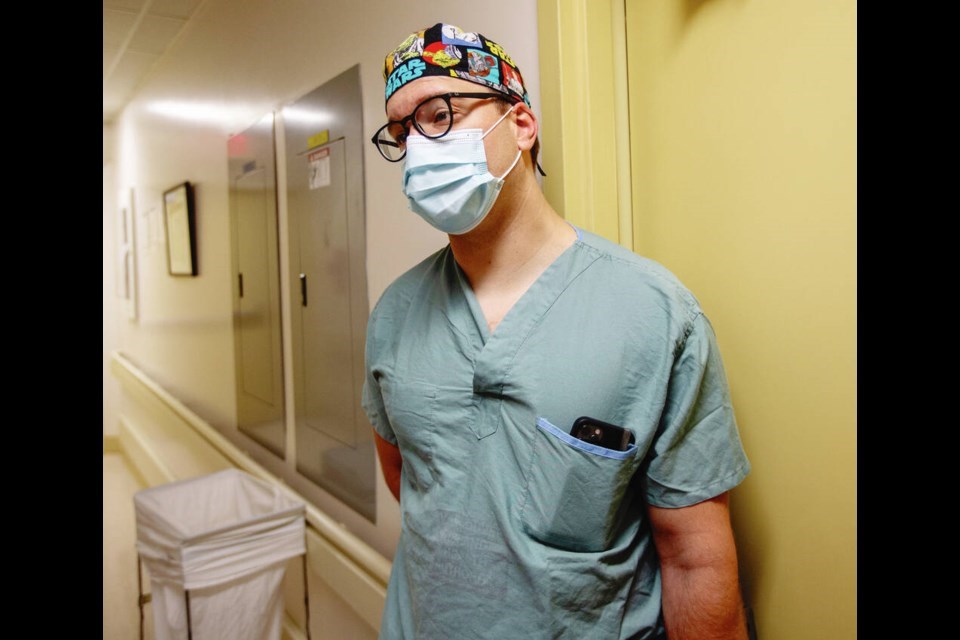If vulnerable seniors in care homes were the face of the pandemic’s first wave, young unvaccinated people intubated in critical-care wards are the hallmark of the fourth.
On any given day in –°¿∂ ”∆µ, the large majority of people in hospital intensive care units are unvaccinated. On Nov. 5, 59 of 64 COVID patients age 59 and younger in ICUs in the province were unvaccinated.
Fully vaccinated people who end up in critical care are almost exclusively elderly with existing health conditions. Of 19 fully vaccinated people in critical care on Friday, 15 were 60 and older.
It’s hard to convey in statistics, however, what ICU registered nurse Carrie Homuth, who manages the adult intensive care unit and high acuity unit for Royal Jubilee, and her co-workers see every day in those hospitals. “When you come down to us and walk through these halls, there is the real story of the pandemic that isn’t captured in those numbers.”
Victoria's Times Colonist toured Royal Jubilee Hospital’s intensive care unit one day in October to pull back that curtain and show what life is like for the people behind the daily COVID statistics — the patients, the doctors, the nurses, the respiratory therapists, the housekeepers.
On that day, ICU lead Dr. Grant McIntyre said all of the ICU patients on the fifth-floor ward were unvaccinated.
“One of the telling things we’ve seen over the last few weeks is that a lot of people, before they are put on life support, pass on to us significant regret,” McIntyre said. “I’ve had people tell me they made a terrible mistake right before they are intubated. It’s a very sad thing to hear.”
Dr. Omar Ahmad, department head of emergency and critical-care medicine for Island Health, said many patients and families are not prepared for the unforgiving nature of the disease. “With COVID, you have healthy people who a month ago were totally fine and now they are on their deathbed.”
Physicians at Royal Jubilee have lost at least one unvaccinated patient in their 20s and multiple patients in their 30s.
“How do you reconcile that in your mind?” Ahmad said. “It’s brutal, it’s heart-wrenching. Families aren’t ready for it.”
Ahmad said he’s held the hands of newly admitted ICU COVID patients and tried to offer hope — “there is so much fear and so much anxiety.” But the reality is that there is not a lot of hope to give.
ICU and ER physician Dr. Adam Thomas wears a Star Wars cap that covers his forehead and a surgical mask that comes up below his eyes, which look weary. “Thirty-, 40- and 50-year-olds shouldn’t be dying at this level,” said Thomas. “We deal with death every day in the ICU but not at this level.”
Thomas, who is 36, said he’s treating fathers his age with young children — putting them on a ventilator “knowing it’s unlikely they’re going to see their kids again.”
It is excruciating for families and it’s taking a toll on health-care workers. “It’s a lot,” he said.
Watching patients die knowing that it was preventable makes the losses harder, health-care providers say.
And it’s getting worse. Since July 1, the mortality of ventilated COVID patients in –°¿∂ ”∆µ has seen a “significant bump” to almost double, Thomas said, although it’s worse in some areas than others.
The spike in deaths coincides with Delta becoming the prevalent variant, Thomas said. “Doing this job we usually have tricks that work, but not a lot works now.”
Some otherwise healthy patients have died within a week of being admitted.
Critical illness progresses differently in different people for a variety of reasons, be it genetic, personal or environmental, but one thing is clear: A patient’s fitness has no effect on how their immune system fights the Delta variant, said Thomas.
In some patients, doctors can’t stop the disease’s progression, he said. “It’s humbling.”
Critical-care nurse Graeme Inglis said it’s the nature of the ICU that some people die and some people live, but it’s been tough to see people work so hard — from housekeepers and porters up to directors — to no avail.
“We don’t always have successful outcomes here, but in the last couple of months especially, we’ve seen a lot of sad tales, families by bedsides,” Inglis said. “I’ve seen young wives, I’ve seen young husbands, get left behind.”
Health-care workers have the added burden of having to conceal their emotions as families look to them to save their loved one — even when everything possible has been tried, said Inglis.
“Unfortunately, the patients living in this state, they don’t know how their decision [not to get vaccinated] has affected them — they can make that decision, and that’s great — but we see the families that are left behind and that’s a very tough thing to watch.”
A small number reject the COVID diagnosis, and some even threaten legal action if they are not given “treatments” that haven’t been proven.
The treatments that are used include steroids, immunotherapies and extracorporeal membrane oxygenation, which is similar to the heart-lung bypass machine used in open-heart surgeries. At one point early on, even lung transplants were performed at the transplant centre at Vancouver General Hospital, but were stopped because of poor outcomes.
“Every treatment that’s proven to be positive, we’re using,” said Ahmad, “but there’s no real magic bullet.
“People are hoping for miracles, but the miracle is the vaccine.”


